Mountain pine: varieties, varieties, planting and care
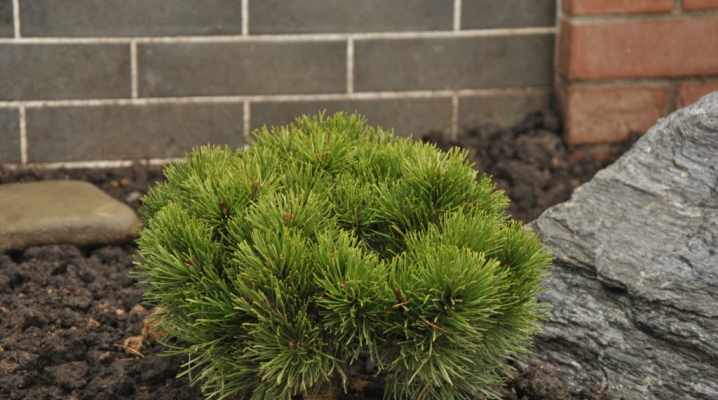
Many people use different types of pine when decorating their gardens and local areas. The mountain variety is considered a popular option. Today we will talk about the features of mountain pine and how to properly care for it.

Description
Often, when selling such a plant, not only the name of the variety itself is used, but also the specific name in Latin Mugo (Pinus mugo). Most often, such pines grow in Southern and Central Europe. Mountain pine is a tall tree with a spherical or broad-ovoid shape. There are such plants with creeping shoots and shoots located in a vertical direction. This variety is distinguished by the most dense placement of branches to each other. The tree trunk is painted gray-brown and has a smooth surface. At the top, small scales may appear on it as the plant matures.
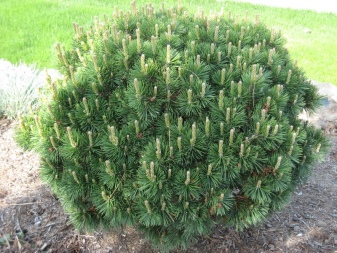

The height of an adult tree can reach almost 1.5 meters, and its diameter is about 2-4 meters. All plants of this species have a well-developed central taproot and spreading outgrowths. Shoot development is slow. They reach a length of about 5-15 centimeters, in breeding plants they can be even smaller. On the hard top of the tree, the vegetation is pointed, it grows in a darker green hue.
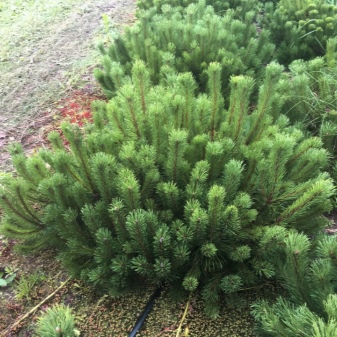
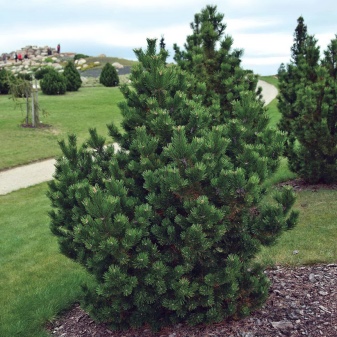
Pine needles are 4-5 cm long, but on some trees it can reach 8-10 cm. They are collected in small bunches. Most representatives of this species have a large number of cones, painted in a gray-brown color scheme. Young fruits most often have a gray-lilac color. Such trees begin to bear fruit and bloom in 5-10 years. Flowering occurs with the appearance of young light-colored cones.
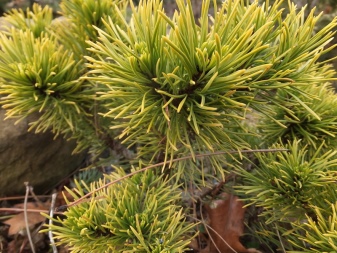
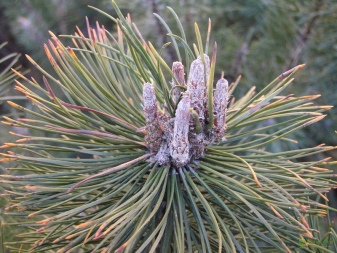
Varieties and varieties
Currently, there are a large number of mountain pine varieties.
- "Dwarf". This variety is a dwarf pine species from Holland. His crown is dense, it has an oval shape. The maximum height of such trees reaches two meters. The diameter of the plant can reach no more than 80-90 cm. This variety is thermophilic.
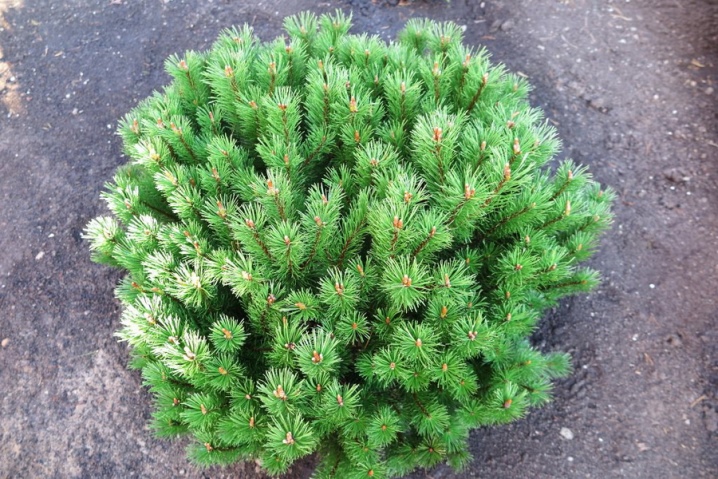
- "Cockade". This mountain coniferous shrub has an interesting iridescent color of the needles (the bases and ends of the needles are yellow, and the middle is green). It was first bred in Germany. The crown of the plant is spreading. The height of the tree can be up to 1.5 meters. It is recommended to plant such a pine in partial shade; it is not a very thermophilic variety.
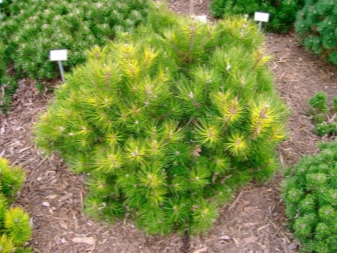
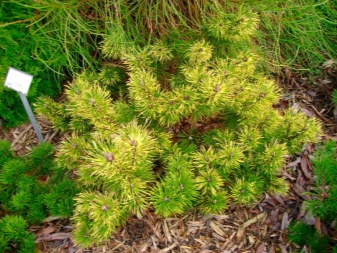
- Pumilio. This species is a small mountainous wild shrub. Plant height can vary from 1.5 to 2 meters. A strong crown is formed by a large number of creeping shoots. Such a pine is unpretentious to care for, it can easily withstand sudden temperature changes. Her needles are tough, they are painted in a dark green color scheme, and their length is about 4 centimeters.
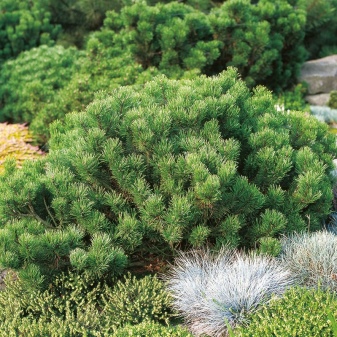

- "Khnizdo". This species was bred by Czech breeders. Such shrubs are compact in size. In the central part, the shoots are much longer than on the sides. "Chnizo" has a beautiful spherical shape, but over time it becomes pillow-like. The height of an adult plant can reach 1-1.2 m. It grows well and develops in partial shade.It has small bumps (3 cm long).
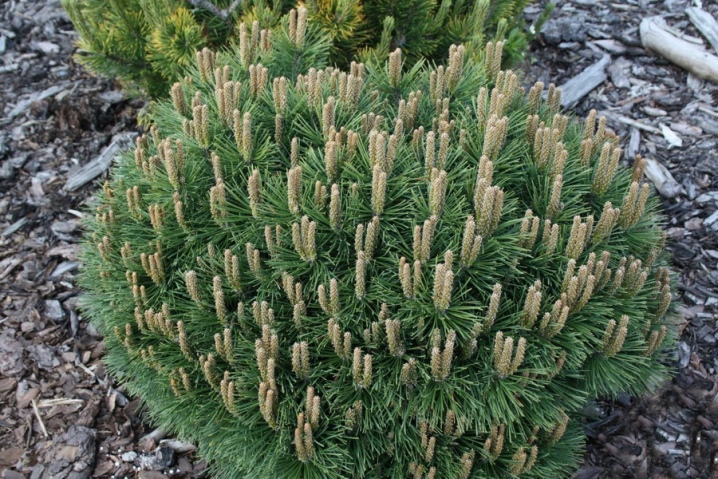
- "Algau". This dwarf pine was bred by Dutch breeders. Plant height can be from 0.7 to 1 meter. The diameter of the circle reaches a little more than a meter. "Algau" has a lush dense crown, so it is often used as a beautiful decorative decoration for the garden. The needles of such trees are dark green in color, the needles are collected in small bunches, they are quite tough and long.
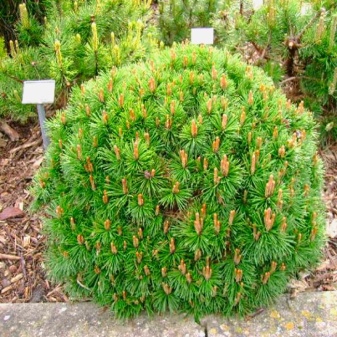

- Sunshine. This pine bush has a beautiful original color. The needles consist of many arched long needles, which are collected in dense bunches. They are yellow at the base, but towards the top they become bright green. It is recommended to plant such pine in areas where it will receive the maximum amount of sunlight. In summer it is better to irrigate it with water.
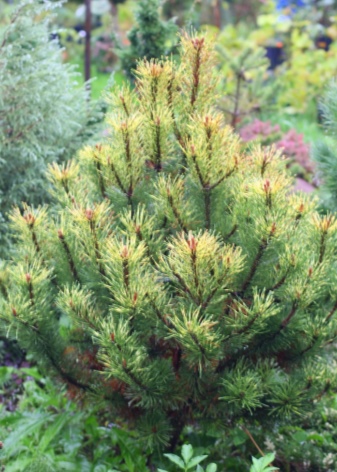
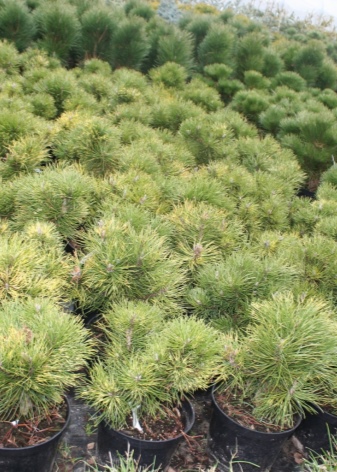
- Golden Glow. Such miniature pine shrubs have a hemispherical crown. They reproduce exclusively through vaccination. The plant reaches a length of only about 0.5 meters. Pine can grow on almost any soil, but it also requires a lot of sunlight.
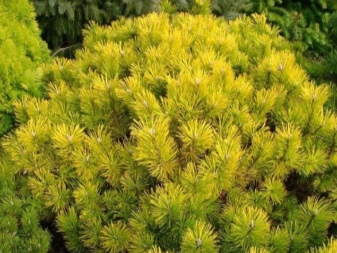

- "Ophir". This variety belongs to dwarf plants obtained by Dutch breeders. Like the previous species, shrubs are propagated by grafting. The height of an adult specimen can be about 80 cm, while its diameter will be almost 1 m. Adult plants can take the shape of a cone. Tough and short needles change color depending on the season. It is better to plant them in areas that are well heated by the sun's rays.
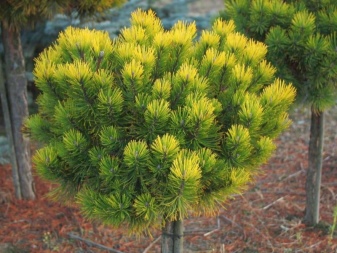
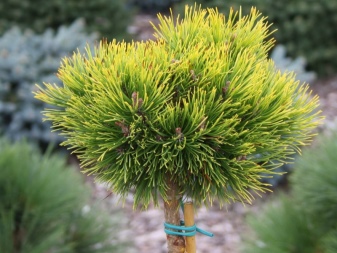
- Benjamin. This dwarf German shrub is most often installed on a stem. Such a pine tree has a dense flat-spherical crown. Often this plant is used to decorate terraces and balconies as an evergreen element. Shiny and tough needles are dark green in color. The variety is unpretentious to care for, it can take root on almost any prepared soil.
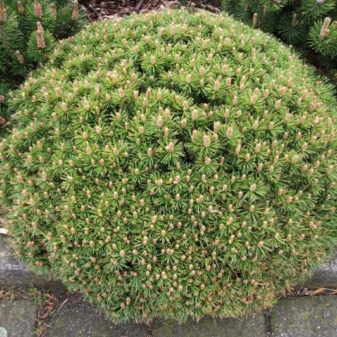
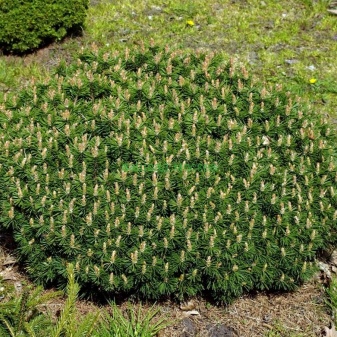
- Carstens Wintergold. This miniature mountain shrub changes color depending on the season. The crown has a hemispherical shape. The dense and short branches of the plant are completely covered with needles with a light green color, they are about 3-5 cm long. With the onset of frost, the color becomes more saturated and bright.
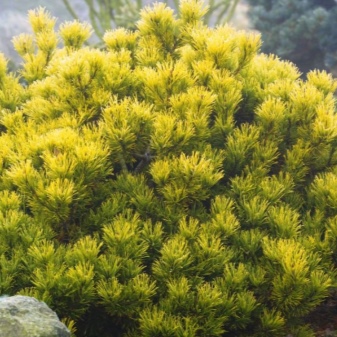

- Jacobsen. This slow-growing variety has slightly curved, thick branches. The needles are dark green, curved and short. As it matures, the plant becomes bare at the base.
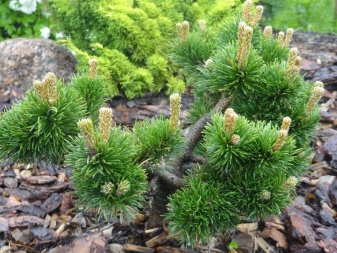
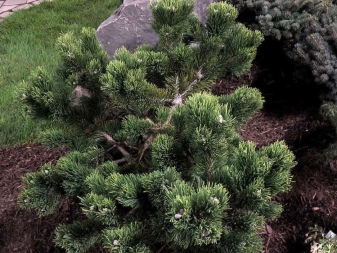
- Humpy. This variety looks like a cushion-shaped dwarf bush with a wide crown. The height of an adult plant can reach only about 80 cm, and its diameter is 1.5 m. The needles are colored dark green, but in winter they become brown, needles reach 4-5 cm in length. Cones are not formed on such a shrub. Can grow in dry soils.
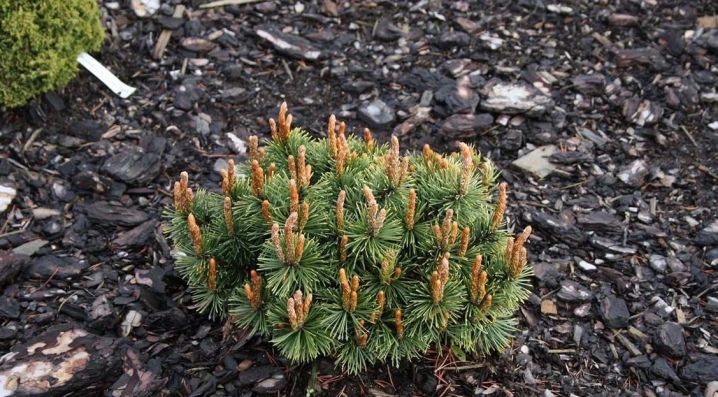
- Columbo. This dwarf variety has a narrow cone-shaped crown. The height of an adult shrub is about two meters. The branches of such a plant are dense, they are located close to each other. The needles are tough, dark green in color, the length of the needles is no more than 5 cm. Small cones on such a plant are formed in large quantities. It can grow even on poor and dry soils.
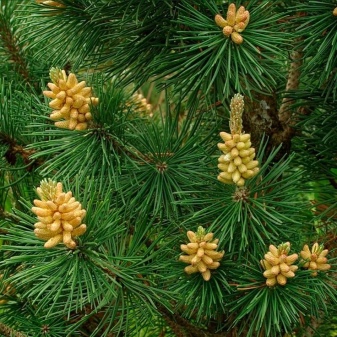
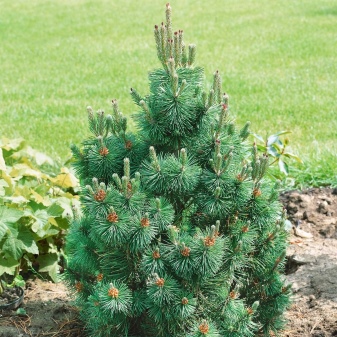
- Columnaris. This shrub reaches a height of about two meters. The crown has a narrow conical shape, the shoots are light green in color. The needles are divided into small bunches. It is shiny and tough and has excellent frost resistance. The cones on such plants are small, they have a dark brown color.
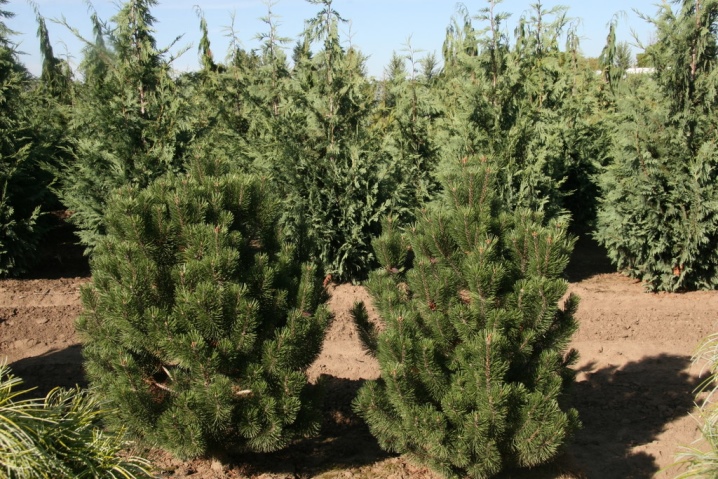
- "Zundert". This cone-shaped dwarf pine shrub has a height of about 0.8 meters. His crown is asymmetric, rounded. The needles are long, light green in color, but their tips are yellow.This type is considered unpretentious, it can grow even on dry and poor soils.
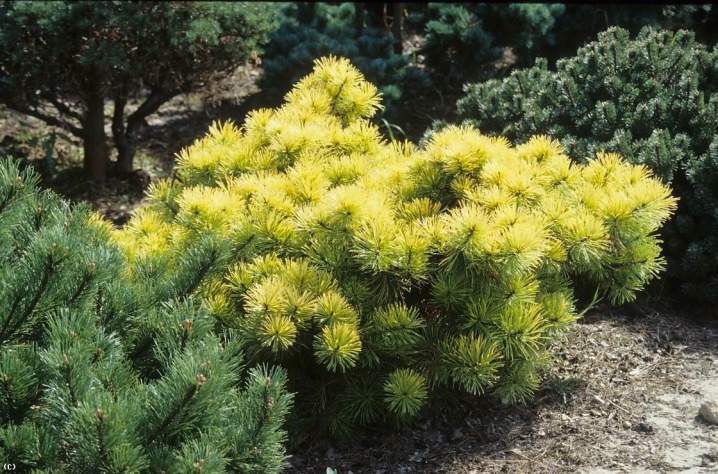
How to plant?
It is recommended to purchase young pine seedlings in special containers from nurseries. The optimal period for planting such plants is spring (mid-April) or late September. Most often, sites are chosen for planting that are well supplied with sunlight, although some individual shrubs develop better in partial shade. Young mountain pine seedlings are unpretentious to the soil. They can grow and develop well and on poor land plots. But at the same time, slightly alkaline and slightly acidic soils are considered the best option.
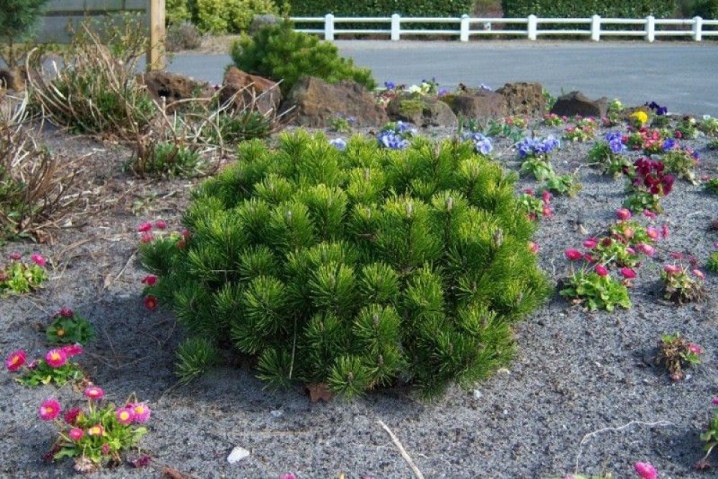
Often, mountain pine is also planted on heavy soils, while doing drainage (at least 20 cm in height). For the substrate, certain proportions of the constituent components should be adhered to (two parts of sod land, half a part of sphagnum and one part of clean sand and clay. You should not pre-soak the seedlings. They should only be slightly damp. Young shoots intertwined with each other must be carefully untwisted, leaving as much substrate as possible.
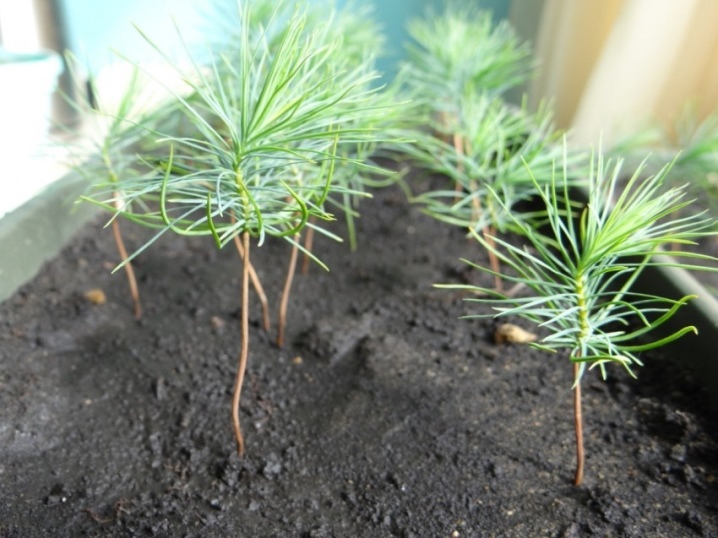
When planting, the height of the seedlings should be taken into account. Tall plants are placed at intervals of 4-5 meters from each other. Miniature breeds can be planted at intervals of just 1.5 meters. When landing, there are some rules to keep in mind. So, when digging holes for seedlings, you need to make a hole according to the size of the spread root system, adding 10-20 cm to this value.
Also remember that when determining the depth of the pit, it is worth considering the drainage layer (15-20 cm). Do not forget about the pre-installation of support for immature plants. At the end, the soil must be watered, mulched and compacted well.
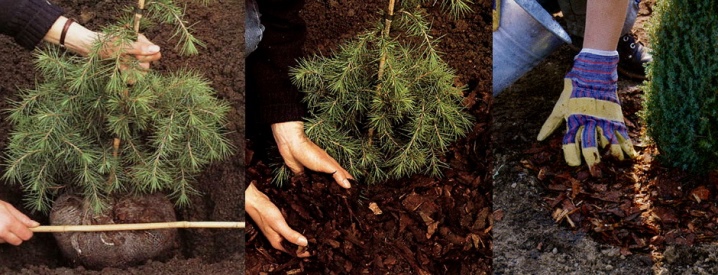
How to take care of it properly?
Only with proper care will mountain pine be able to grow and develop normally on your land. Wherein an important place is occupied by feeding, watering, mulching, pruning and preparing plants for winter.
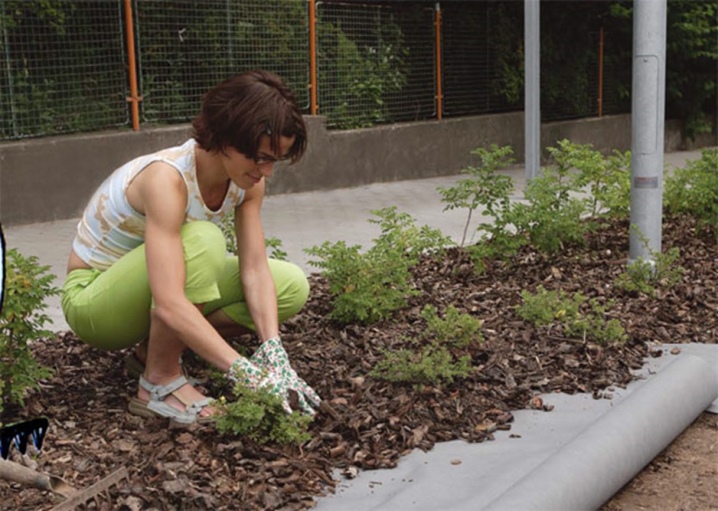
Top dressing
In the first two years after planting in open ground, the plants must be fed. Moreover, in the case of an increase in the amount of special substances, a full-fledged tree can grow from the bush. It is not recommended to carry out top dressing before winter, as this can cause a sharp growth of branches that will die in the cold. Nitrogen-containing components occupy an important place when feeding mountain pine. They need to be brought into the planting hole. In the spring, it is worth using exclusively complex formulations. In the fall, the pines are not fertilized.
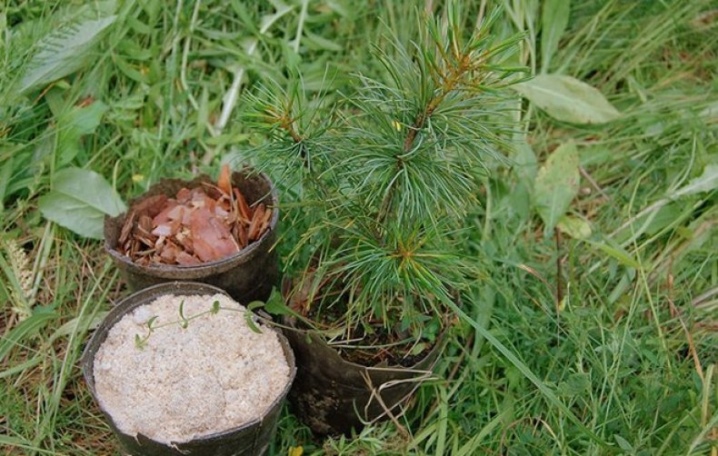
Two years after the trees are planted in the ground, it is no longer necessary to fertilize them. After all, they will receive all the substances and vitamins necessary for their normal development from the coniferous litter.
Watering
Within 30 days after planting seedlings in open ground, they are watered around the perimeter of the trunk circle. The procedure is carried out every 2-4 days. The amount of water should be up to 10-15 liters. Watering is required both in summer and autumn. It is worth moistening the earth when a lump of earth with a sharp compression begins to quickly crumble. For adult plants, watering in the form of natural precipitation will most often be sufficient. Sprinkler irrigation is best during dry periods. In the middle of autumn, the soil is well watered so that the soil can absorb enough moisture.

Mulching and loosening
Loosening should be carried out only for some time after planting the plants (it is necessary to loosen the trunk circle). After 1-2 years, it is better to switch to mulching. Mulching can be carried out using forest coniferous mass, coniferous sawdust. Sometimes this procedure is carried out with peat. This allows you to keep moisture in the soil and not carry out additional loosening. In this case, it is recommended to remove weeds immediately. Otherwise, they will take away water and necessary food.

Pruning
The crown of a mountain pine needs to be cut a little so that it does not grow. Such plants easily tolerate this procedure. Reduce shoots by only one third, this will make the crown much more beautiful and dense. It is better to free trees from dried branches in the spring. Pinching should also be carried out periodically.
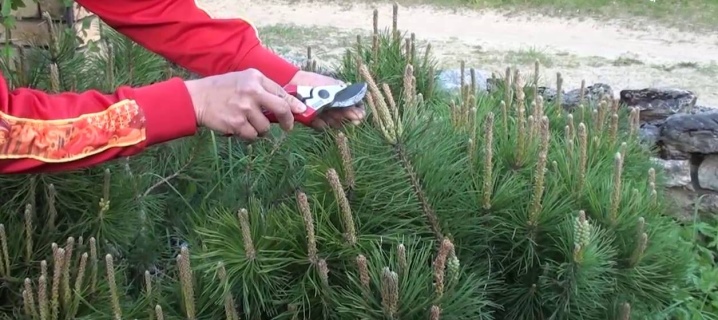
Preparing for winter
Almost all varieties of mountain pine have excellent frost resistance. After all, their shoots fully ripen in the spring of the year, and then lignify. If the temperature gets too low (-35?), Then the tops of the pines will suffer and lose their appearance. To keep plants in good condition after winter, there are some rules to follow.
- Young plants are covered with special material. This can be a special agrotextile or spruce branches. Such a technique will help protect pines not only from severe frosts, but also from the scorching sun after the winter period.
- Plants are mulched in autumn. This procedure should be done after the last watering at this time of year. This is done, as a rule, with sawdust or pine bark.
- Tying branches too high. This procedure is done so that the branches do not break under a large mass of snow.
- Sprinkling peat on the branches. This should only be done if ice has formed on them.
- Check shrubbery in February and March. At this time, you need to be especially careful so that snow does not accumulate inside, as this can become a special lens for reflecting rays and completely burn out the bases of young shoots.
- Watering with warm water after waking up. Watering is carried out after the snow has completely melted.


Reproduction methods
Mountain pine can reproduce in a variety of ways. Cuttings can be difficult to tolerate with such conifers, but it is used if it is impossible to propagate them with seeds. At the same time, a stalk is carefully cut from a young branch. It is kept for 10-12 hours in a solution with a special substance that stimulates growth. If you are going to grow pine in a container, then you need to prepare the soil mixture in advance. A cutting is placed in it to a depth of no more than 3-5 cm, and then greenhouse conditions are created.
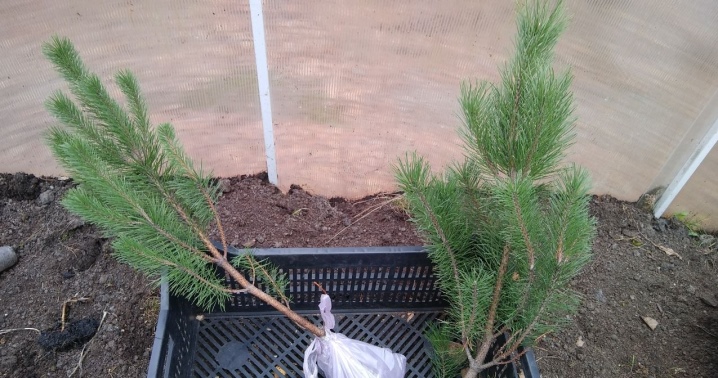
Seed material allows you to grow mountain pine at home in pots or outdoors. The seeds are thoroughly pretreated in a solution with Fundazol or Fitosporin.

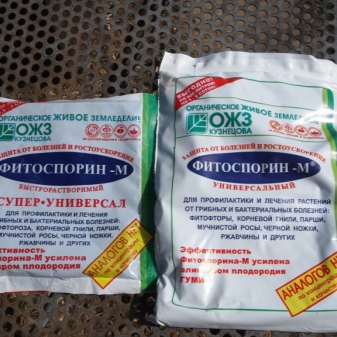
After that, the prepared seeds are placed in a loose substrate. Seed material immediately after planting is thoroughly watered with clean water and slightly covered with a special film, it will be possible to remove it only after the first green leaves appear. The first shoots should appear within one month. It is better to transplant a plant to a permanent place in 1-2 years.
Diseases and pests
Despite its unpretentiousness, mountain pine is still subject to some diseases. At the same time, the resistance of trees and shrubs planted in saline and dense soil increases significantly. Some varieties of such pine suffer from blister rust. A red bloom appears at the ends of the needles. To prevent such a disease from appearing, you can periodically treat pine with preparations containing copper.
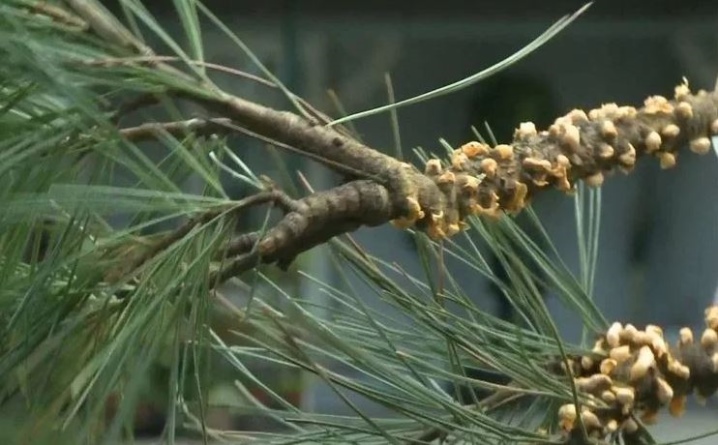
Fungal disease is also common among conifers. It most often occurs on young trees after winter. At the same time, the needles acquire a reddish-brown hue with small black dots. Often, the disease leads to complete drying of the branches. To prevent fungal disease, it is worth carrying out a sparse planting of young seedlings. Also, as a preventive measure, you can use timely sufficient watering and feeding. If the plant is already infected, then its treatment can be carried out with a solution of colloidal sulfur.The fallen needles must be burned immediately.
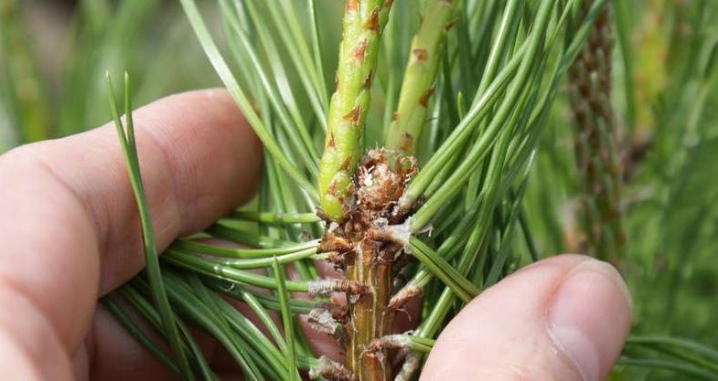
Often, bark necrosis is also found on conifers. In this case, the bark quickly turns yellow, it begins to dry out and completely die off. Small rashes appear in these areas over time. This disease occurs due to severe frosts or droughts. To get rid of this disease, it is necessary to carry out a regular pruning procedure to the first living bud. It is also necessary to do treatments with fungicides and preparations that contain copper. They need to be done in autumn, spring and early summer.
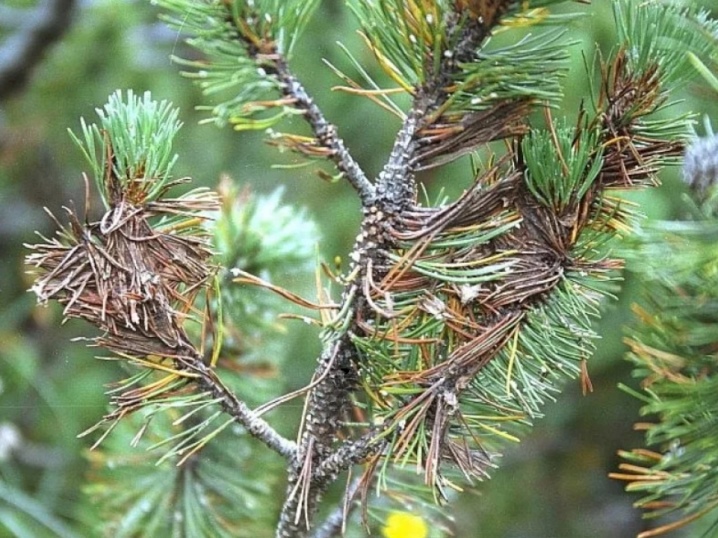
Another disease is scleroderriosis. As a result of infection, the buds located on the top of the coniferous bush first begin to dry out and die off, and then all the branches die. The complete death of the plant can be prevented only by timely removal of the affected parts.
Mountain pine often suffers from the effects of pests. One of them is aphid. When this parasite appears, the coniferous shrub will quickly turn yellow, then the needles will begin to fall off. To remove the pest, it is necessary to spray with insecticides immediately after its detection, this procedure should be carried out at intervals of two weeks until the aphid completely disappears.
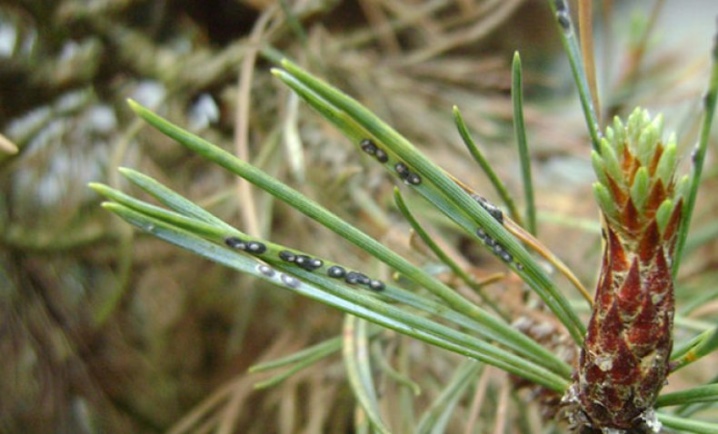
Pine scabbard can also damage trees. First, insects settle in the middle of the crown, clinging to the base of the shoots. Over time, the needles acquire a brown color and completely fall off. Such parasites are most often well hidden under the needles, so it is almost impossible to completely remove them. When a spider mite appears on a plant, its young shoots gradually begin to be covered with thin cobweb threads. Pests move along them. Then the needles acquire a brown tint and begin to fall off en masse. When such a parasite appears, the pine must be immediately treated with chemicals, otherwise it will quickly die.
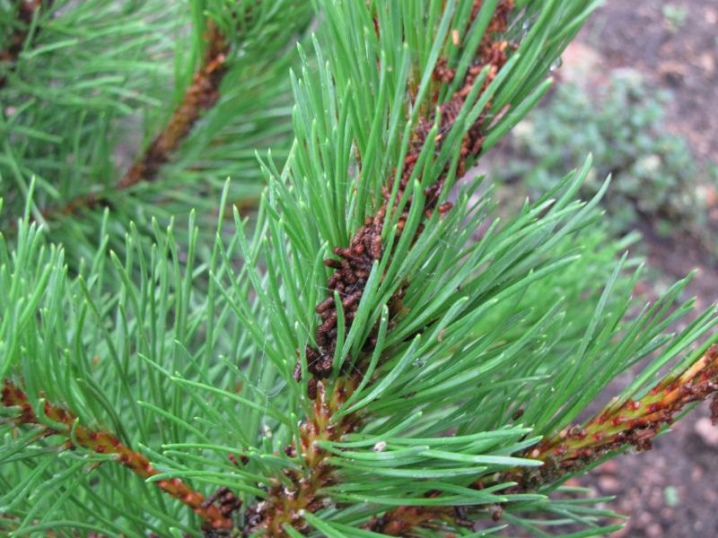
There may be bark beetles on the mountain pine. These parasites make holes in the bark in which the females lay their eggs. The hatched larvae make the passages deeper. Finally, they pupate inside the plant. It is difficult to fight a pest so that it does not appear at all, it is worth taking preventive measures. If you are still going to remove parasites, then for this you can make special traps with pheromones. They are fixed on the pine trunk. Beetles flock to them even from great distances.

Sawflies often damage the needles. The larvae eat the young growths of the plant, which leads to the drying out and death of the branches. It is easy to remove pests; this can be done by periodic spraying with any insecticide.
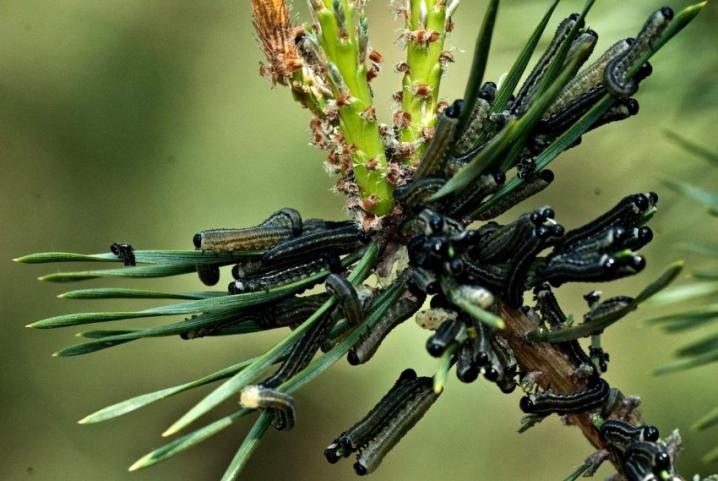
Sometimes the mountain pine is also damaged by Hermes. As a result of their activity, round neoplasms are formed on plants. Pest females suck sap from the bush, and their larvae spoil the kidneys.
Hermes should be dealt with immediately with the help of chemicals (acaricides and insecticides). It is necessary to carry out 2-3 treatments with systemic insecticides. These drugs include "Aktara", "Aktellik", "Fitoverm", "Confidor".
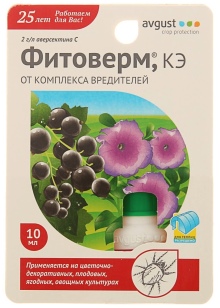

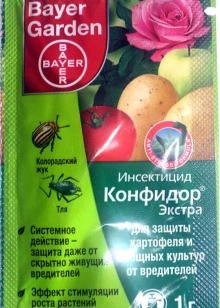
Examples in landscape design
Mountain pine is often used to create beautiful garden compositions. You can arrange them in a variety of designs. An excellent option would be to plant several small conifers of different types on the site. Moreover, the place where they will grow can be decorated with stones of different sizes and colors.

Landscaping with several large and lush spherical shrubs would also be a good option. They can be surrounded by massive relief stones for decoration. In this case, you can use both the same plants and different types of such coniferous shrubs.
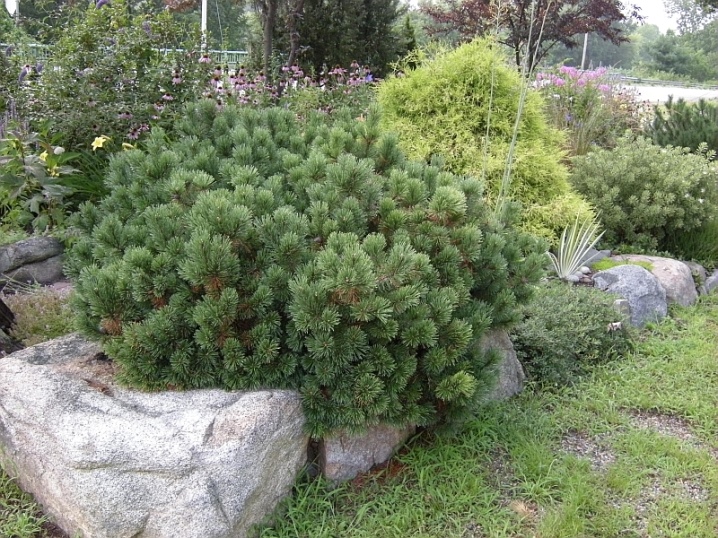
The design will look interesting, in which a small plot of land is separated by a fence made of medium-sized decorative stones, and several tall and slender deciduous and coniferous trees are planted on the territory of this place in the central part. Then they are surrounded by low dwarf shrubs of mountain pine of various types and shades.
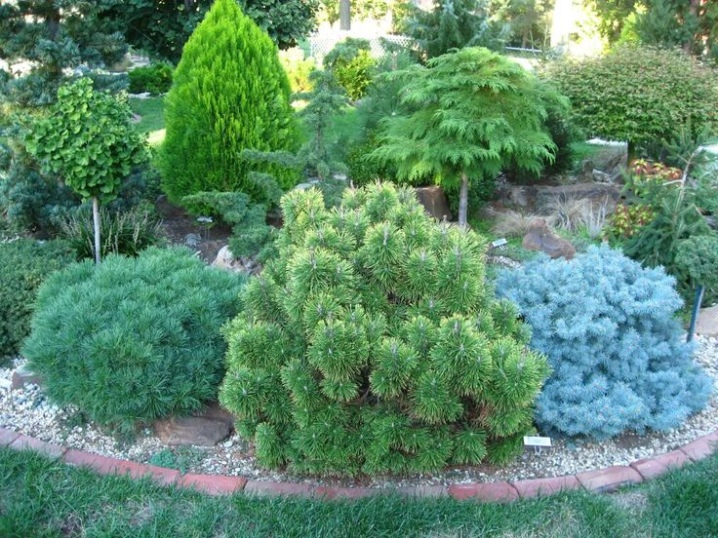
The stairs in the garden are often decorated with mountain pine bushes. From them you can make a small section of decorative small stones. There they plant a coniferous plant.You can dilute the design by planting several small deciduous plants there.
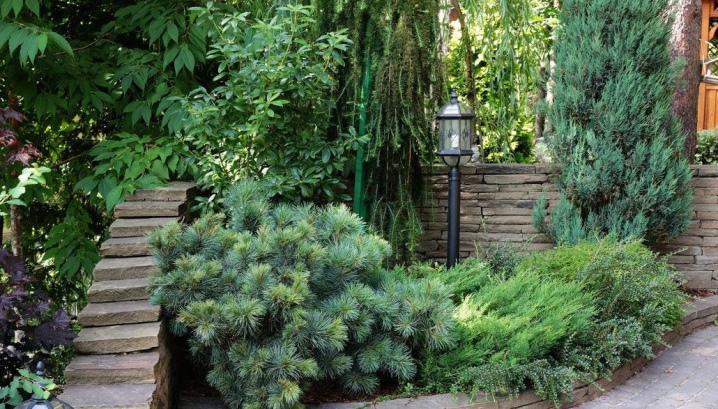
Often the decoration is done near the house in the garden. It is also better to make a separate area next to it using decorative flat rectangular stones. You can use the material of almost any color. To make the design more original, it is permissible to make the fence an uneven wavy line.
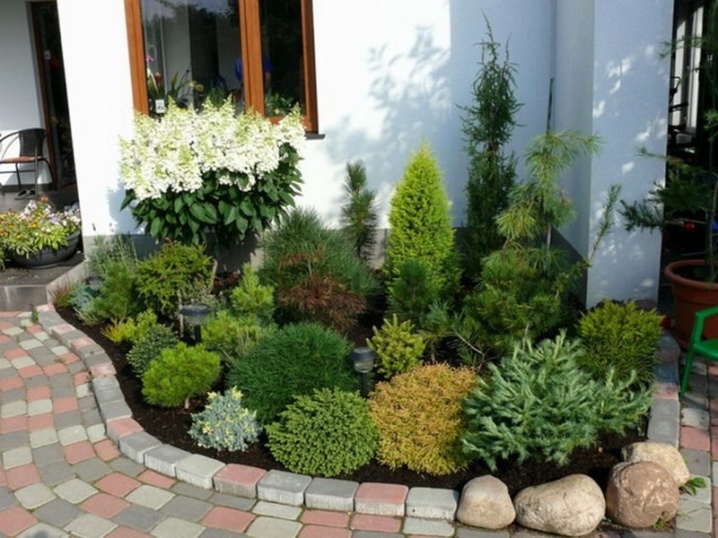
In a fenced area, you can plant many miniature mountain pine shrubs at once. It is better to select different types with different colors and shapes to make the composition more noticeable and interesting. It can be diluted with a few taller, deciduous, flowered shrubs.
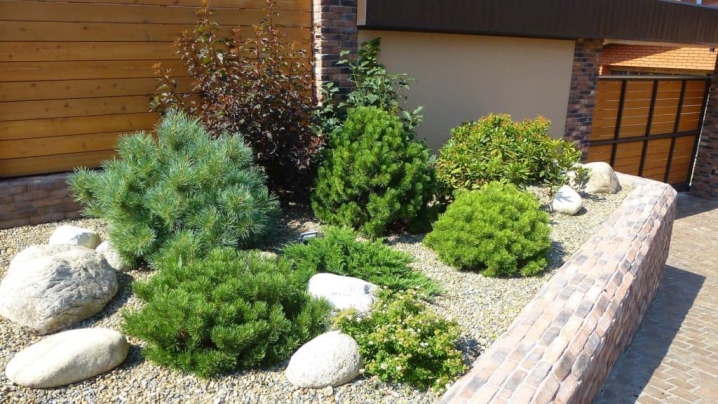
For information on how to properly care for a mountain pine, see the next video.



































































The comment was sent successfully.